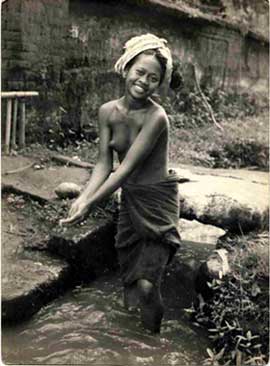

During the second half of the 20th century Bali became an inspiring destination for some of Australia’s most distinguished artists, whether en route, or staying long enough to record their impressions, tantalised by intimations of a life still innocent enough to be an ideal haven for body and soul. Artists that immediately come to mind are Donald Friend and Ian Fairweather. Arthur Fleischmann another, slightly lesser known Australian artist became so captivated by Bali that he could never shake its influence during an all-to-brief decade in Sydney, or during his long career in London where he spent the last forty years of his life. Born in Bratislava in 1896, Arthur Fleischmann qualified as a medical doctor but soon turned to sculpture, which he studied in Vienna. In 1937 he left Europe for South Africa, then via Zanzibar travelled to Indonesia, staying in Bali for two years. He would have remained there had it not been for the invasion by Japan in 1939, forcing him to seek refuge in Sydney. Here he settled for the next ten years, becoming part of the celebrated artists’ commune of Merioola. But those two years in Bali were especially formative, witnessing a fluorescence of Fleischmann’s vision. For many who fled the instability of Europe during the 1930s, the southern hemisphere represented a distant escape, and Bali especially, the artist put it, as ‘a land of complete harmony between nature and the people, their art and customs.’ And it produced more than the sculpture he is best known for: 'I came to Bali as a sculptor, and the Balinese have been a tremendous inspiration in my work. But sculpting is slow… such that it can give only a few crystallised symbols of life. Photographs can capture the beauty of the human figure, especially the beauty of Balinese women.' With a miniature Dolina camera and 35mm film he took many hundreds of photographs, enlarged ‘with the aid of daylight and an old wooden box camera fixed in the opening of the blacked out window.’ Markets, harvesting scenes, temples, landscapes; all were captured by his roving lens; but it was especially the Legong dancers, with their movement and lithe bodies adorned with richly textured costume, who appealed most to his sculptor’s sensibility. Fleischmann intended to publish a book, Bali through a sculptor’s eyes, but it never eventuated, the prints and negatives remaining stored in his St John’s Wood studio after his death in London in 1990. Now at last, through the efforts of his widow Joy and son Dominique, it is to be published by Pictures Publishers in the Netherlands, specialists in art books pertaining to Indonesia. The text by Paul de Bont is based on Fleischmann’s original manuscript written in Sydney between 1939 and 1948. Governor Marie Bashir, a good friend of the family, has written a foreword and will launch the book at the Gallery, Friday 4 May, 6.30pm. The artist's widow and son will be at the launch. Bookings on 9225 1878. The launching of this book is commemorated by a Focus Room installation featuring Fleischmann’s sculpture from the collection, including a recently acquired sketchbook, and a selection of his photographs emanating at once a haunting world of paradise then, and a defining moment in the life of an artist. More information may be found on the Arthur Fleischmann Foundation website The Focus Room is sponsored by Macquarie Bank 
|